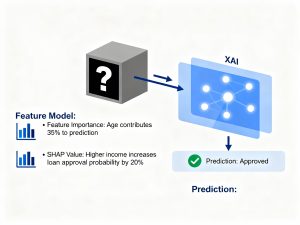The success of any application hinges not only on its features and performance but also on its reliability, security, and usability. This is where Quality Assurance (QA) and Quality Control (QC) step in, playing pivotal roles in ensuring the delivery of software that meets these criteria. While the two terms are often used interchangeably, they represent distinct approaches to managing quality in software development.
Quality assurance (QA) revolves around creating a structured and efficient process to prevent defects during the development stage. In contrast, quality control (QC) focuses on identifying and rectifying defects in the finished product. Together, QA and QC form the backbone of software testing strategies, ensuring products not only meet technical requirements but also provide a seamless user experience.
In this blog, we will look into the concepts of QA and QC, exploring their differences, their complementary roles, and their real-world applications. From coding examples to testing strategies, this blog is designed to provide developers, testers, and aspiring quality management professionals with a comprehensive understanding of these vital concepts. Whether you’re new to the field or looking to enhance your knowledge, understanding the difference between quality assurance and quality control is a crucial step toward mastering software quality management.
What is Quality Assurance (QA)?
Quality Assurance (QA) is a proactive, process-oriented approach that ensures the software development life cycle (SDLC) adheres to pre-established standards and best practices. QA is all about building quality into the process to minimize the chances of defects or bugs in the final product.
Key Aspects of QA:
- Preventive Focus: QA aims to identify potential problems during the development phase rather than fixing them post-deployment.
- Standards Compliance: QA ensures adherence to coding standards, frameworks, and methodologies, such as Agile or Waterfall.
- Continuous Improvement: QA involves constant monitoring and refining of processes to ensure optimal performance.
QA Example: Automating Unit Tests
Unit tests ensure individual components or modules work as expected. Writing unit tests early in the development phase is a classic QA practice.
Example: Unit Testing with Python’s unittest Module
python
import unittest
def add(a, b):
return a + b
class TestMathFunctions(unittest.TestCase):
def test_add(self):
self.assertEqual(add(2, 3), 5)
self.assertEqual(add(-1, 1), 0)
if __name__ == "__main__":
unittest.main()
In this example, QA ensures the addition function behaves correctly for different inputs.
What is Quality Control (QC)?
Quality Control (QC) is a reactive, product-focused approach that revolves around identifying and resolving defects in the finished product. Unlike QA, QC activities occur after the software has been developed to ensure it meets predefined specifications.
Key Aspects of QC:
- Defect Identification: QC involves testing the software to uncover bugs or flaws.
- Product-Oriented: The primary focus is on the end result, ensuring it performs as expected under various scenarios.
- Validation: QC validates the product’s functionality, usability, and performance.
QC Example: Automated API Testing
QC often involves automated testing to validate the functionality of APIs.
Example: API Testing with Postman and Newman
bash
# Run a collection of tests using Newman
newman run api-tests.postman_collection.json -e test-environment.postman_environment.jsonThis command tests an API collection using Postman’s Newman CLI, ensuring the API behaves as expected in different environments.
Difference Between Quality Assurance (QA) and Quality Control (QC)
Understanding the difference between quality assurance and quality control is crucial for software teams. Here’s a more detailed explanation:
- Focus: QA is process-oriented, while QC is product-oriented.
- Timing: QA activities occur throughout the development process; QC is primarily performed at the end of development.
- Goal: QA’s goal is to prevent defects; QC’s goal is to identify and resolve defects.
Example: QA vs QC in Continuous Integration/Continuous Deployment (CI/CD)
- QA: Setting up a CI pipeline to automate build and test processes.
- QC: Running regression tests to ensure new changes don’t introduce bugs.
Key Components of Quality Assurance
- Process Definition: Define standards, workflows, and processes (e.g., Agile sprints).
- Test Automation: Automate repetitive tasks to ensure efficiency.
- Training: Train developers and testers in QA tools and methodologies.
- Documentation: Maintain clear documentation for processes and test cases.
Example: Automating QA in CI Pipelines
yaml
name: QA Pipeline
on:
push:
branches:
- main
jobs:
test:
runs-on: ubuntu-latest
steps:
- uses: actions/checkout@v2
- name: Install Dependencies
run: npm install
- name: Run Tests
run: npm testThis YAML script defines a QA pipeline using GitHub Actions, ensuring automated tests run whenever code is pushed to the main branch.
Key Components of Quality Control
- Functional Testing: Ensure the software behaves as expected.
- Regression Testing: Validate that new changes don’t break existing functionality.
- Defect Tracking: Use tools like JIRA to log and track bugs.
- User Acceptance Testing (UAT): Involve end-users to ensure the software meets real-world needs.
Example: Functional Testing with Cypress
javascript
describe('Login Page Tests', () => {
it('should display an error for invalid credentials', () => {
cy.visit('https://example.com/login');
cy.get('#username').type('invalid_user');
cy.get('#password').type('wrong_password');
cy.get('#login-button').click();
cy.contains('Invalid username or password').should('be.visible');
});
});This QC test ensures the login functionality works correctly under invalid input scenarios.
Complementary Relationship Between QA and QC
QA and QC are complementary processes. While QA builds quality into the development process, QC ensures that the final product meets quality standards. Together, they create a robust quality management system that minimizes risks and maximizes customer satisfaction.
Why Pursue a Career in Quality Management?
A career in quality management is rewarding and offers excellent growth opportunities. Professionals skilled in QA and QC are in high demand across industries, especially in software development.
Benefits of a Career in QA/QC:
- Exposure to cutting-edge technologies.
- Opportunities to work in diverse industries.
- High demand for professionals with expertise in automation tools.
Skills and Requirements for Quality Assurance and Quality Control Jobs
- Technical Skills: Proficiency in testing tools like Selenium, JIRA, and Postman.
- Programming Knowledge: Familiarity with scripting languages like Python or JavaScript.
- Attention to Detail: Ability to identify and analyze defects effectively.
Conclusion
Quality is the cornerstone of successful software development, and the combined efforts of quality assurance and quality control ensure that every product delivered to the market meets the highest standards. While QA focuses on building quality into the development process, QC ensures that the finished product aligns with user expectations and technical requirements. Together, they form a synergistic relationship that minimizes defects, improves efficiency, and enhances user satisfaction.
Understanding the difference between QA & QC is not just about semantics—it’s about recognizing their distinct purposes and how they work together to create robust, reliable, and scalable software. QA helps establish a culture of continuous improvement by identifying process inefficiencies, while QC validates the end product through rigorous testing techniques.
As technology evolves, the importance of QA and QC in maintaining software quality continues to grow. Automation tools, advanced testing frameworks, and methodologies like Agile and DevOps have further revolutionized how these practices are implemented in the industry. Pursuing a career in quality management offers unparalleled opportunities to work with cutting-edge technologies, enhance customer satisfaction, and contribute to the creation of flawless digital products.
For professionals and organizations alike, embracing both QA and QC as integral components of the software development lifecycle is the key to building trust with users and staying competitive in the ever-changing tech landscape. By mastering these concepts, you’re not just ensuring the quality of your product—you’re shaping the future of innovation.



